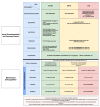Anticoagulation in Patients with End-Stage Renal Disease: A Critical Review
- PMID: 40565400
- PMCID: PMC12193158
- DOI: 10.3390/healthcare13121373
Anticoagulation in Patients with End-Stage Renal Disease: A Critical Review
Abstract
Background: Chronic kidney disease (CKD) and its advanced stage, end-stage renal disease (ESRD), affect millions worldwide and are associated with a paradoxical hemostatic imbalance-marked by both increased thrombotic and bleeding risks-which complicates anticoagulant use and demands clearer, evidence-based clinical guidance.
Design: This study is a critical review synthesizing the current literature on anticoagulant therapy in CKD and ESRD, with emphasis on altered pharmacokinetics, clinical complications, and therapeutic adjustments.
Data sources: PubMed, Scopus, and Google Scholar were searched for articles discussing anticoagulation in CKD/ESRD, focusing on pharmacokinetics, clinical outcomes, and dosing recommendations.
Study selection: Studies examining the safety, efficacy, and pharmacokinetics of anticoagulants-including heparin, low-molecular-weight heparin (LMWH), warfarin, and direct oral anticoagulants (DOACs)-in CKD and ESRD populations were included.
Data extraction and synthesis: Key findings were summarized to highlight the dose modifications, therapeutic considerations, and clinical challenges in managing anticoagulation in CKD/patients with ESRD. Emphasis was placed on balancing thrombotic and bleeding risks and identifying gaps in existing guidelines.
Results: Patients with CKD and ESRD exhibit a paradoxical hypercoagulable state marked by platelet dysfunction, altered coagulation factors, and vascular endothelial damage. This condition increases the risk of thrombotic events, such as deep vein thrombosis (DVT) and pulmonary embolism (PE), while simultaneously elevating bleeding risks. Hemodialysis and CKD-associated variables further complicate the management of coagulation. Among anticoagulants, unfractionated heparin (UFH) is preferred due to its short half-life and adjustability based on activated partial thromboplastin time (aPTT). Low-molecular-weight heparins (LMWHs) offer predictable pharmacokinetics but require dose adjustments in CKD stages 4 and 5 due to reduced clearance. Warfarin necessitates careful dosing based on the estimated glomerular filtration rate (eGFR) to maintain an international normalized ratio (INR) ≤ 4, minimizing bleeding risks. Direct oral anticoagulants (DOACs), particularly Apixaban, are recommended for patients with eGFR < 15 mL/min or those on dialysis, although data on other DOACs in CKD remain limited. The lack of comprehensive guidelines for anticoagulant use in CKD and ESRD highlights the need for individualized, patient-centered approaches that account for comorbidities, genetics, and clinical context.
Conclusions: Managing anticoagulation in CKD/ESRD is challenging due to complex coagulation profiles and altered pharmacokinetics. Judicious dosing, close monitoring, and patient-centered care are critical. High-quality randomized controlled trials are needed to establish clear guidelines and optimize therapy for this vulnerable population.
Keywords: CKD; DOAC; ESRD; anticoagulation; heparin; warfarin.
Conflict of interest statement
The authors declare no conflicts of interest.
Figures
Similar articles
-
Unfractionated heparin versus low molecular weight heparins for avoiding heparin-induced thrombocytopenia in postoperative patients.Cochrane Database Syst Rev. 2017 Apr 21;4(4):CD007557. doi: 10.1002/14651858.CD007557.pub3. Cochrane Database Syst Rev. 2017. PMID: 28431186 Free PMC article.
-
Antithrombotic therapy for ambulatory patients with multiple myeloma receiving immunomodulatory agents.Cochrane Database Syst Rev. 2021 Sep 28;9(9):CD014739. doi: 10.1002/14651858.CD014739. Cochrane Database Syst Rev. 2021. PMID: 34582035 Free PMC article.
-
Direct oral anticoagulants versus warfarin for preventing stroke and systemic embolic events among atrial fibrillation patients with chronic kidney disease.Cochrane Database Syst Rev. 2017 Nov 6;11(11):CD011373. doi: 10.1002/14651858.CD011373.pub2. Cochrane Database Syst Rev. 2017. PMID: 29105079 Free PMC article.
-
Home versus in-patient treatment for deep vein thrombosis.Cochrane Database Syst Rev. 2018 Jan 9;1(1):CD003076. doi: 10.1002/14651858.CD003076.pub3. Cochrane Database Syst Rev. 2018. PMID: 29315455 Free PMC article.
-
Anticoagulation for the long-term treatment of venous thromboembolism in people with cancer.Cochrane Database Syst Rev. 2018 Jun 19;6(6):CD006650. doi: 10.1002/14651858.CD006650.pub5. Cochrane Database Syst Rev. 2018. PMID: 29920657 Free PMC article.
References
-
- Levey A.S., Eckardt K.-U., Dorman N.M., Christiansen S.L., Hoorn E.J., Ingelfinger J.R., Inker L.A., Levin A., Mehrotra R., Palevsky P.M., et al. Nomenclature for Kidney Function and Disease: Report of a Kidney Disease: Improving Global Outcomes (KDIGO) Consensus Conference. Kidney Int. 2020;97:1117–1129. doi: 10.1016/j.kint.2020.02.010. - DOI - PubMed
-
- Huijben J.A., Kramer A., Kerschbaum J., de Meester J., Collart F., Arévalo O.L.R., Helve J., Lassalle M., Palsson R., Ten Dam M., et al. Increasing Numbers and Improved Overall Survival of Patients on Kidney Replacement Therapy over the Last Decade in Europe: An ERA Registry Study. Nephrol. Dial. Transplant. 2023;38:1027–1040. doi: 10.1093/ndt/gfac165. - DOI - PMC - PubMed
Publication types
LinkOut - more resources
Full Text Sources
Research Materials
Miscellaneous


